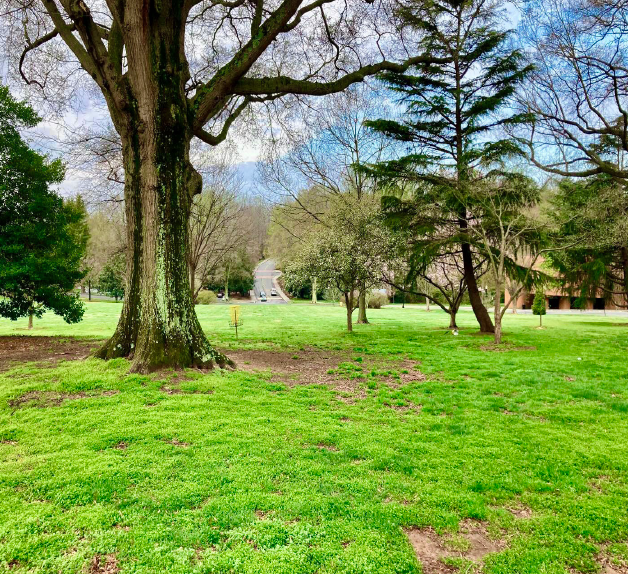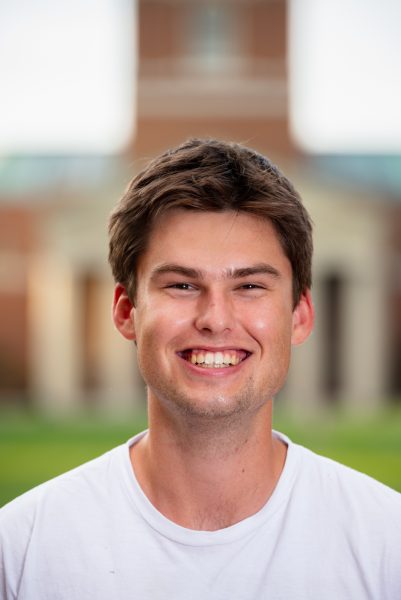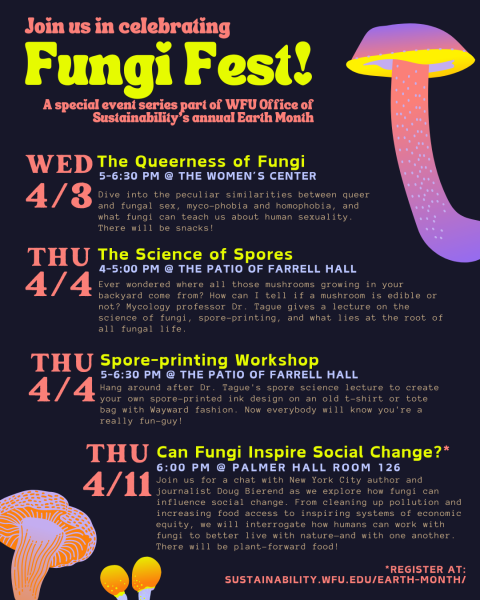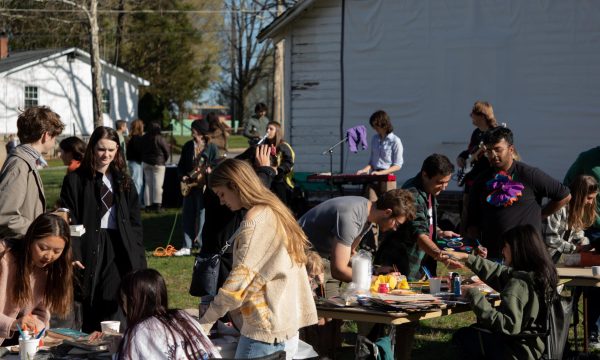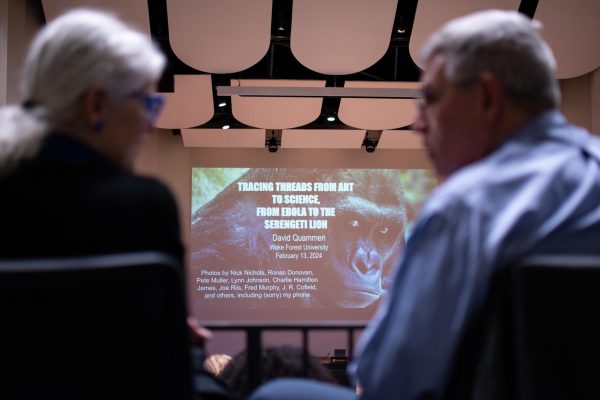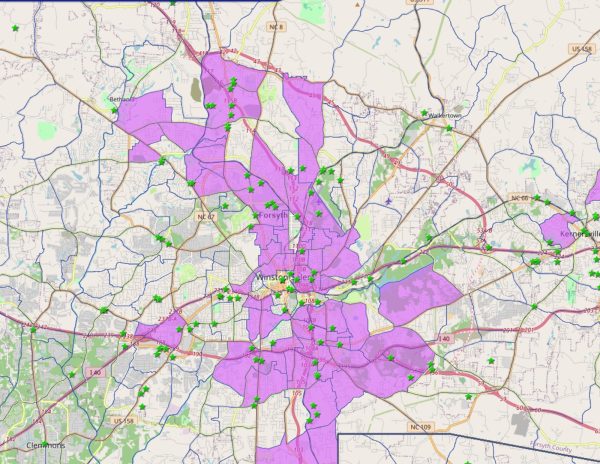Davis Field construction alters campus sustainability
The planned re-routing of Wake Forest Road through Davis Field may have mixed environmental effects
Many are concerned that the new road will disrupt the outdoor beauty and recreation space Davis Field currently offers.
March 29, 2022
On May 16, Hearn Plaza will not only be the center of campus but the center of attention. The trees that line the upper quad will be surrounded by flying graduation caps, flying toilet paper rolls and feelings of joy and accomplishment.
On May 17, Davis Field will be receiving a different, less celebratory type of attention. The towering oaks will be surrounded by fencing, caution tape and the onset of change as construction crews begin the process of creating a road through the middle of the campus’s largest green space.
Announced on March 16, Wake Forest Road will be rerouted through Davis Field, leading cars directly towards the Taylor and Davis Residence Halls. On the opposite side of Hearn Plaza, Lot N will be converted from visitor parking into a centralized stop for all Wake Line shuttles.
“The planning for this has been in the works for quite a while in various forms,” said project manager for the Davis Field construction Jill Perry.
Crews began the preliminary work of staking out the boundaries for a new humanities building set to be built on the eastern corner of Davis Field by Olin Laboratory in February 2020. In an interview with the Old Gold & Black, former president Nathan Hatch said that “groundbreaking would likely occur in the late fall of 2020, and that the building would likely open no sooner than the fall semester of 2022.”
This timetable was decimated when COVID-19 shut down the university and the building plans a few weeks later. But this was not the first proposal for Davis Field’s development.
In the 1950s, Jens Frederick Larson, the campus architect, drew a plan in which a road connected both East and West entrances. From 1956 to 1991, cars were able to drive through Davis Field onto Hearn Plaza with ease. But because of the road’s accessibility to both Reynolda Road and University Parkway, many local drivers used Wake Forest Road as a cut-through. To reduce the rise and risk of traffic, Wake Forest Road was reconfigured into the winding shape it is in now — and Davis Field was born.
Perry explains that the reasoning to put the road through Davis Field again was more than just improving the arrival experience.
“Its secondary benefit is future planning,” Perry said. “This precinct with the library, Benson and Reynolda, there is a vision of pedestrianizing this area and not having too much traffic [by Lot C]. By bringing this road [through Davis Field], it would allow us to bring traffic in, for them to go [towards Wait Chapel] and allow us to make it safer for students and people to walk.”
The construction of this road will force the removal of 11 trees and the reconfiguration of electrical cables for the Davis Field tents. None of the Legacy Oaks or Magnolias on Davis Field will be removed. Perry said that any tree that is removed would be replanted alongside the extended road to maintain the “same type of Davis field feel.”
Environmental concerns have been raised about increased runoff from the impervious surface of the road. According to Steve Fisenne, Director of the Environmental Health and Safety Department, the chances of runoff being a serious issue are low.
“We just have to modify [our storm drains on the lower half of the field] so that it can take a higher flow rate, especially if we have another storm like [the one on March 23],” Fisenne said.
For the construction on Lot N, sustainable rainwater capture will also be one of the focuses of the renovations.
Located in between Poteat and Kitchin Residence Halls, Lot N will look very different for students when they return in the fall. One of the crucial aspects being addressed during this construction process will be the stormwater system for all runoff north of Hearn Plaza, with the parking lot becoming a bio-swale for rainwater collection.
“The idea is that the rainwater will go in and it filters down through fabric and soil down to the storm water system,” said project manager for Lot N construction Kim Jackson. “That’s kind of a cool feature.”
However, this is an underground makeover. The more visible alterations will be when visitor parking spaces are converted into a centralized shuttle stop complete with two bus shelters. The 40-foot long shelters will look similar to the ones in between Collins and South Residence Halls.
The island in the center of Lot N will be narrowed and parking spaces will be paved over with black concrete, allowing enough space for multiple Wake Line shuttles to park and maneuver around the loop simultaneously. In addition to those changes, an extra right lane will be added to Wake Forest Road coming from University Parkway, as well as a median on that side of the road.
“They’re going to line up the entrance from University Parkway with the entrance to the circle,” said Campus Lab Program Coordinator for the Office of Sustainability Nathan Peifer. “Right now, the shuttles have to go over maybe four speed bumps [as they go from Benson to University Parkway]. Now they would just have to pass through two or three crosswalks.”
The change would reduce the time shuttles are spent idling exhausting carbon dioxide and makes the shuttles more cost-efficient as each route will take less time and gas to complete.
“When you build infrastructure, you’re committed to it for a long period of time,” Peifer said. “That’s why sustainable design is really important in terms of getting ahead.”
Peifer continued: “It gets you into a deeper conversation about our transportation and the carbon impact of our shuttles. That’s a more significant sustainability story; moving the roads rather than putting the road in.”
Jackson said that three of the five Dogwood trees that will be removed from the Lot N island have already been replaced on campus.
Jackson said that Campus Recreation has expressed concerns about the construction encroaching onto Poteat Field. She responded that she is exploring long-term fencing options that would delineate campus green space and development space.
“There’s another tree on the other side that our arborist Jim Mussetter was really concerned about,” Jackson said. “It’s a bald cypress. He was adamant that we save that, so that tree will be saved and it will have a brick wall around it.”
As Perry put it, these types of projects can be quite jarring for those who are used to a certain look and feel of campus, however, they are well-intentioned.
“It might seem very unsettling at first to think of shuttles coming in here or a road coming up through our field,” Perry said. “But the goal is really to improve collectively the campus as a whole.”


